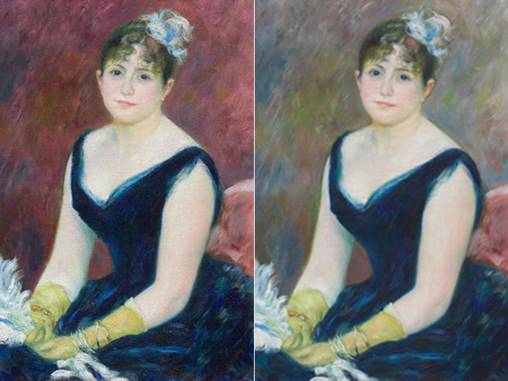By Dr Mark Windsor
The workshop that I delivered at LASAR’s recent schools event held at Westminster Abbey, ‘Science, Religion and Big Questions’, focused on the relationship between science and art (specifically, art history) by examining the real-life case study of Renoir’s fading painting. What is interesting about this case study for thinking about disciplinary ways of knowing is that it provides an example of scientists and art scholars working toward a common purpose. Using a laser technique called surface-enhanced Raman spectroscopy, conservation scientists working at the Art Institute of Chicago have revealed the extent to which Renoir’s painting, Madame Léon Clapisson (1883), has dramatically faded. Using the results, they have been able to produced a re-colourised visualisation of how it might have appeared when it was first painted.
By comparing the kinds of questions that art historians and scientists ask when investigating Renoir’s painting and the methods they use to answer those questions, students gained an understanding of the distinctive power and limitations of these disciplines. Students in the workshop identified that science is well equipped to answer questions about the material properties of art works (such as ‘what pigments did Renoir use to paint Madame Léon Clapisson?), and is ill equipped to answer questions about the meaning and value of art works (such as ‘is Madame Léon Clapisson a good painting?’). Students also identified a question that appears to be amenable to both science and art history, namely, ‘how did Renoir’s audience see Madame Léon Clapisson at the time?’
If science cannot resolve questions about meanings and values in art, the case of Renoir’s painting shows that it can nonetheless illuminate answers to those questions. This provides an interesting comparison to the disciplinary relationship between science and religion. Where there seems nothing especially remarkable or unusual about scientists and art scholars working together on a shared project, it might seem odd to find scientists and scholars of religion working together; but if both art scholars and scholars of religion are interested in questions about human purposes, meanings and values, why should these cases be so different?
Photo credit: Pierre-Auguste Renoir, Madame Léon Clapisson, 1883. Oil on canvas; 81.2 × 65.3 cm. The Art Institute of Chicago, 1933.1174. Recolourised visualisation of Madame Léon Clapisson by Kelly Keegan. Courtesy the Art Institute of Chicago.

